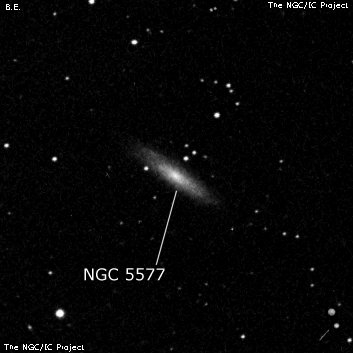
George Johnstone Stoney, Lord Rosse's assistant, discovered NGC 5577 on 26 Apr 1849. While observing NGC 5576 he recorded "16' nf NGC 5576] there is a L, F ray about 4.5'x1', gvlbM." Two years later (12 May 1850), he described this "Nova" as "pB, D* close preceding, * in nf edge." Although the identification is certain, the separation is only 10' northeast of NGC 5576 as noted by d'Arrest, who measured an accurate position.
400/500mm - 17.5" (3/23/85): fairly large, very elongated WSW-ENE, very diffuse, low surface brightness. Faintest of three in a group with NGC 5576 10' SSW.
600/800mm - 24" (6/8/13): moderately bright, large, very elongated ~7:2 SW-NE, ~3.0'x0.9', broad concentration to large, brighter central region but no distinct core or nucleus. A mag 15.5 star is at the east flank of the NE extension and two mag 15.5 stars are off the west flank on the NE side. Largest but faintest (by far the lowest surface brightness) of trio with NGC 5576 10' SSW and NGC 5574 12.6' SSW.
Notes by Steve Gottlieb